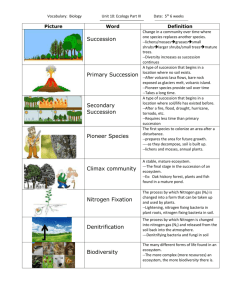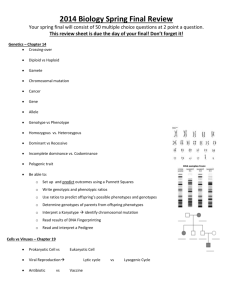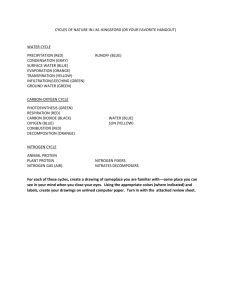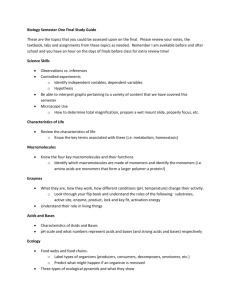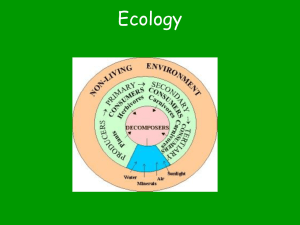Answers to Mastering Concepts Questions
advertisement
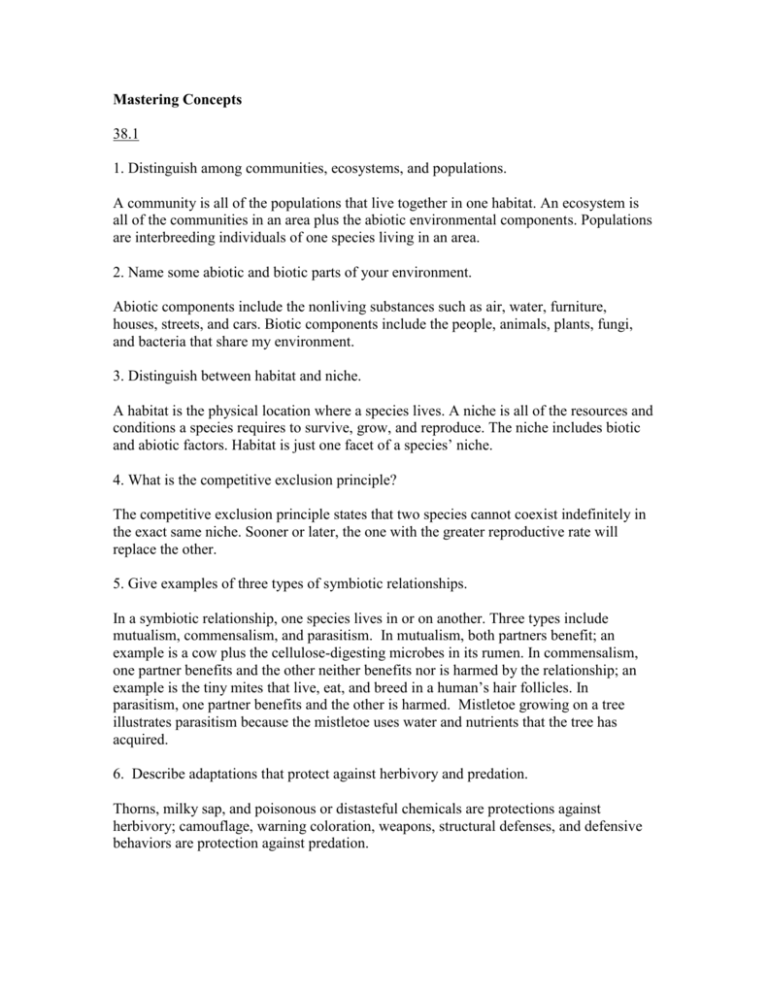
Mastering Concepts 38.1 1. Distinguish among communities, ecosystems, and populations. A community is all of the populations that live together in one habitat. An ecosystem is all of the communities in an area plus the abiotic environmental components. Populations are interbreeding individuals of one species living in an area. 2. Name some abiotic and biotic parts of your environment. Abiotic components include the nonliving substances such as air, water, furniture, houses, streets, and cars. Biotic components include the people, animals, plants, fungi, and bacteria that share my environment. 3. Distinguish between habitat and niche. A habitat is the physical location where a species lives. A niche is all of the resources and conditions a species requires to survive, grow, and reproduce. The niche includes biotic and abiotic factors. Habitat is just one facet of a species’ niche. 4. What is the competitive exclusion principle? The competitive exclusion principle states that two species cannot coexist indefinitely in the exact same niche. Sooner or later, the one with the greater reproductive rate will replace the other. 5. Give examples of three types of symbiotic relationships. In a symbiotic relationship, one species lives in or on another. Three types include mutualism, commensalism, and parasitism. In mutualism, both partners benefit; an example is a cow plus the cellulose-digesting microbes in its rumen. In commensalism, one partner benefits and the other neither benefits nor is harmed by the relationship; an example is the tiny mites that live, eat, and breed in a human’s hair follicles. In parasitism, one partner benefits and the other is harmed. Mistletoe growing on a tree illustrates parasitism because the mistletoe uses water and nutrients that the tree has acquired. 6. Describe adaptations that protect against herbivory and predation. Thorns, milky sap, and poisonous or distasteful chemicals are protections against herbivory; camouflage, warning coloration, weapons, structural defenses, and defensive behaviors are protection against predation. 7. Define coevolution and describe an example. In coevolution, two species influence the directions of each other’s evolution and subsequent adaptations. An example is the relationship between a flowering plant and its pollinator. The flower’s shape may accommodate only one or a few types of pollinators. In turn, those pollinators have mouthparts that are well-suited only for that type of flower. 38.2 1. How do ecologists measure species diversity in a community? Two measures of species diversity are species richness and relative abundance. Species richness is the total number of species in a habitat. Relative abundance describes the proportion of the community that each species represents. 2. How is natural selection apparent in ecological succession? Succession is a change in species composition over time, and it occurs because one set of species alters the environmental conditions in such a way that other species can begin to exploit the habitat. In changing the conditions, they are altering the selective forces that determine whether or not an organism can survive and reproduce in the habitat. 3. What processes and events contribute to primary and secondary succession? Primary succession begins with the emergence of a new habitat; secondary succession begins with disturbance to an existing community. In both cases, pioneer species are the first to arrive. These species change the environment in ways that permit other species to thrive. In theory, the community continues to change until a stable climax community is in place. 4. How do disturbances prevent true climax communities from developing? Pockets of local disturbance create patches in different successional stages throughout the habitat. These disturbances (fires, trees falling, storm damage) happen frequently enough to prevent a true climax community. 38.3 1. Identify the trophic levels of a food chain. Primary producers are plants and other autotrophs that can produce their own organic matter. Primary consumers eat primary producers, secondary consumers eat primary consumers, and tertiary consumers eat secondary consumers. Decomposers eat dead organisms and organic wastes. 2. What sources of energy sustain ecosystems? The ultimate source of energy that sustains most ecosystems is the sun. Some ecosystems are sustained by potential energy in inorganic chemicals. 3. What roles do primary producers and decomposers play in ecosystems? Primary producers use inorganic raw materials to create organic molecules. Decomposers break down these organic molecules, releasing the inorganic nutrients that primary producers need. 4. Woodpeckers dig nesting cavities in tree trunks; many other bird species subsequently use abandoned woodpecker cavities. In these forest communities, what term might be used to describe woodpeckers? The woodpeckers are keystone species because their influence on community structure is far greater than their biomass might suggest. 5. How efficient is energy transfer between trophic levels in food webs? About 2% to 30% of the energy available to a trophic level is fixed into tissue and made available to the next higher trophic level, with an overall average of 10%. The rest is lost as heat. 6. Draw an energy pyramid for an ecosystem with three levels of consumers. Answers may vary, but the pyramid might include producers (100 kcal), primary consumers (10 kcal), secondary consumers (1 kcal), and tertiary consumers (0.1 kcal) 7. Explain how biomagnification disproportionately affects organisms at the top of a food chain. Biomagnified chemicals are stored in fatty tissues and are not biodegradable. All of these molecules that are present in one trophic level are therefore concentrated into the much smaller biomass that makes up the next highest level. Top consumers therefore acquire the highest concentrations in their tissues. 38.4 1. What features do biogeochemical cycles share? The elements in all biogeochemical cycles are stored in abiotic reservoirs (atmosphere, water, and rocks/soil) and in biotic reservoirs (organisms). Autotrophs are organisms that absorb the elements from abiotic reservoirs incorporate them into organic molecules. These organic molecules pass to organisms in the other trophic levels. All organisms, including decomposers, return the elements to their abiotic reservoirs. 2. Describe the main abiotic reservoirs for the water, carbon, nitrogen, and phosphorus cycles. For the water cycle, the main storage reservoirs are larger water bodies such as the oceans, lakes, and rivers. Soil and the atmosphere also store a significant amount of water. For the carbon cycle, the main abiotic reservoir is the atmosphere. Oceans, carbonate rocks, soil organic matter, and fossil fuels are other large carbon reservoirs. For the nitrogen cycle, the main abiotic reservoir is the atmosphere; soil and ocean sediments also store large amounts of inorganic nitrogen. For the phosphorus cycle, the main abiotic reservoir is phosphate-rich rocks. 3. What unique roles do bacteria and archaea play in the nitrogen cycle? Nitrogen-fixing bacteria and archaea are the only organisms that can transform N2 from the atmosphere into a form that plants can use. Nitrification and denitrification are also critical processes that are unique to bacteria and archaea. 4. How can nutrient pollution lead to O2-depleted water? In the presence of sunlight, nutrients such as nitrogen and phosphorus stimulate the growth of algae. Initially the algae release O2 in photosynthesis, but soon their cells die and sink to the bottom of the water column. There, decomposers consume O2 from the water as they decompose the algae. 5. Describe how a terrestrial ecosystem can interact with a faraway aquatic ecosystem. The biogeochemical cycles reveal many ways that terrestrial and aquatic ecosystems interact: through the air and water currents and through runoff from land to water. In addition, in some cases, migratory animals can carry nutrients from the land to the ocean and back. 38.5 1. Describe the relationship between panic grass, the fungus, and the virus. The virus infects the cells of the fungus, which, in turn, infects the grass. The grassfungus-virus relationship allows for all three species to colonize warm habitats that they could not otherwise occupy. 2. The fungus–virus partnership helped young grass plants survive at very high temperatures. What would be the benefits of inoculating all of our food crop plants with the fungus–virus team? What else would you need to know before recommending that strategy? Can you think of any possible drawbacks? Food crop plants might better withstand heat stress, possibly increasing yields. To determine whether to inoculate a plant, you would need to know whether the fungus or virus causes disease in the plant or whether they would change the food crops in ways that might harm humans. Drawbacks could include unintended large-scale change to ecosystems. Also, growing crops in hotter areas might increase irrigation demands in areas where water is already scarce. Write It Out 1. How does a community differ from an ecosystem? A community is a group of interacting populations that inhabit the same region. An ecosystem includes a community plus the nonliving environment within a defined area. 2. Three Galapagos finch species have different beak sizes and specialize in different types of food. Explain how these three species can share the same habitat without driving each other to extinction. Since the finches have different diets, they occupy different niches. Competition is therefore unlikely between these finch species. 3. List examples of adaptations that enable an organism to compete with other species, live inside another species, find food, and avoid herbivory or predation. How does each adaptation contribute to the organism’s reproductive fitness? An example of an adaptation that enables an organism to compete is the rapid growth of a seedling, which may shade out others as it acquires light energy. More photosynthesis means more energy for reproduction. An adaptation that enables an organism to live inside another is the head of a tapeworm, which has hooks that keep the worm from being flushed out of an animal’s digestive tract. A worm with such hooks acquires more food than one without, which means more energy is available for reproduction. An example of an adaptation that helps an animal find food is an eagle’s keen eyesight. An eagle that can spot small animals acquires more food than one with poor eyesight. An example of an adaptation that helps an organism avoid predation is camouflage. An animal that can avoid being eaten (at least before reproductive age) has a chance at reproductive success. 4. Researcher G. F. Gause tested how two species of paramecia (one-celled protists) responded to food availability. When grown in separate dishes, each population’s size was proportional to the amount of food (the more food, the larger the population). However, when both species were grown in the same dish, only one species survived. What conclusions about competition can you draw from these two results? The first result indicates that within a species, competition for food is the main factor determining an individual’s survival. The second experiment is an example of the competitive exclusion principle. When Gause put two species together, one species outcompeted the other, leading to extinction of the less competitive population. 5. In an example of mimicry, a harmless species such as a jumping spider physically resembles an aggressive species of ant. Explain why this type of mimicry can exist only if the spiders are less abundant than the ants. If a harmless species were more abundant than the noxious one it is mimicking, predators would not be fooled. Mimicry works because a predator learns by experience whether or not a species is harmful. If the harmless species is more abundant, the predator will learn that the majority of its encounters with similar-looking creatures are not painful. 6. When Mount St. Helens erupted in 1980, areas nearest the volcano were devastated. Farther away from the blast, the disturbance was milder. Predict how the rate of forest succession would change with distance from the volcano, and explain your prediction. Farther from the blast site, secondary succession would be at work since the habitat was not completely devastated. Therefore rates of succession would be much faster than near the blast site, where the soil and most if not all life was destroyed. 7. Suppose a plot of forest is cleared of trees in anticipation of a new shopping mall. However, after the bulldozers are gone, the company runs out of money, and the land sits undisturbed for many years. Describe the events that may occur in the years following the damage to the forest. What are these community changes called? The land was disturbed but not destroyed. The soil was left intact, and many smaller plants likely remained. The events of secondary succession would therefore commence. Fast-growing species like weeds and herbs would be the first to become abundant. Then grasses and shrubs would become more common. Finally, slower-growing trees would begin to shade the weeds and grasses. After a few decades, the forest would again be mature. 8. Imagine that you could build a covered enclosure around a small ecosystem, blocking out all light and preventing gas exchange with the environment. How would the total amount of organic material, available energy, and nutrients in the ecosystem change over time? Without light, most or all primary production would cease (some autotrophs do not use light energy to produce food, but most do). With no energy entering the ecosystem, producers would soon die. Without food, herbivores would also die, followed by consumers. Decomposers would break down the dead bodies, converting organic matter into CO2 and H2O and releasing heat. After the last decomposer died, all of the energy in the ecosystem would have been released as heat and all of the organic material would have been converted into CO2, H2O, and other inorganic substances. However, the total amount of nutrients in the ecosystem would not have changed throughout this process. All of the phosphorus that was once in producers, consumers, and decomposers would end in the soil. Nitrogen and carbon would be distributed between the atmosphere and the soil. 9. Humans exterminated wolves in the Rocky Mountains by the 1930s, but starting in the 1990s, wolves were reintroduced to the northern Rockies. Predict how elk populations fluctuated in the years preceding wolf extermination and in the years following wolf reintroduction. Elk typically eat foliage from shrubs and trees, which birds and beavers require. How might bird and beaver populations have changed since the 1990s? As wolves were eliminated, the death rates in elk populations declined, leading to an increase in population size. Elk consumed more shrubs and trees, destroying the resources that birds and beavers use to make their homes. Once wolves were reintroduced, elk populations decreased, shrubs and trees grew taller and fuller, and bird and beaver populations grew steadily as resources became more readily available. 10. Use the second law of thermodynamics and a pyramid of energy to explain why most food chains have four or fewer levels. The second law of thermodynamics says that energy is lost as heat every time it is converted from one form to another. As a result, only a small proportion of the energy available at one level of a food chain is available to be transferred to the next level. These energy constraints keep most food chains limited to four or fewer levels. 11. In a eutrophic lake, algae are abundant and dissolved oxygen levels are low. Predict how the pyramid of energy might appear for an ecosystem under these conditions. When nutrient levels are unusually high in a lake, algae have abundant resources. Their populations grow, leading to a high amount of biomass at the bottom of the energy pyramid. However, eutrophic lakes have a low dissolved oxygen level, which kills many animals. Because the amount of energy moving to primary, secondary, and tertiary consumers is limited, the energy pyramid would have a broader base than usual, with smaller than usual rectangles on top. 12. Mountain yellow-legged frogs live in the Sierra Nevada mountains. Their tadpoles mainly eat algae. One predator of adult frogs is a garter snake, which is eaten by bullfrogs. Recently, a chytrid fungus has infected adult mountain yellow-legged frogs and caused their population size to fall. How might this change affect the algae, garter snakes, and bullfrogs? With fewer tadpole grazers, algae populations might increase. Lower numbers of adult mountain yellow-legged frogs limits the amount of food available to garter snakes, which might decrease garter snake population size. Fewer garter snakes might lead to lower numbers of bullfrogs. 13. A nematode worm causes the abdomen of a tropical ant to turn bright red, resembling a berry that fruit-eating birds often consume. Sometimes a bird eats an ant instead of a berry, and the nematode infects a new host. Use this story to explain how parasites can affect food webs. The parasite causes the bird to eat an insect that it would not typically consume. In this case, a bird that is typically a primary consumer becomes a secondary consumer. Also, the parasite causes ants to face an unusual predator, which may affect the population size of the ants. 14. Use the carbon cycle to trace a hypothetical path of a carbon atom from Abraham Lincoln’s body into your own. Abraham Lincoln may have exhaled a carbon atom as CO2. That gas may have circulated in the atmosphere for a long time, until a plant absorbed the carbon atom and incorporated it into its own tissues. The carbon atom may have circulated within a food web, including animals and decomposers, until it was finally absorbed as CO2 and incorporated into the tissues of a plant that I ate. 15. Suppose your friend says “I hate germs! I wish we could kill all the bacteria in the world!” What would happen to your friend if she didn’t have bacteria in her body? What would happen to nutrient cycles without bacteria? Without her bacterial companions, your friend would be much more vulnerable to infection, and she would lose the ability to digest some components of her food. Nutrient cycles would collapse without bacteria, which are important decomposers and autotrophs. In addition, only bacteria and archaea can fix nitrogen, so ecosystems would eventually collapse in their absence. 16. Review the structures of organic molecules in chapter 2. How do the molecules in living cells connect the carbon, nitrogen, and phosphorus cycles? Carbon is part of all organic molecules, while nitrogen occurs in proteins and nucleic acids, and phosphorus occurs in nucleic acids, ATP, and phospholipids. Molecules that contain combinations of C, N, and/or P represent intersections of the nutrient cycles. Pull it Together 1. Where do mutualism, commensalism, and parasitism fit into this concept map? All are examples of symbiotic interactions in a community. 2. How are decomposers and autotrophs essential to ecosystem function? Decomposers release inorganic nutrients from organic molecules. Autotrophs incorporate these inorganic nutrients into organic molecules, which sustain all food webs. 3. Distinguish between primary and secondary succession. Primary succession occurs in new habitats or in areas where soil has been destroyed. Secondary succession occurs in areas that are disturbed but that retain intact soil. Relative to primary succession, secondary succession is quite fast. 4. Make another concept map that shows nutrient cycling on land. Include producers, consumers, decomposers, carbon, nitrogen, phosphorus, atmosphere, and soil. You may also add other concepts. The concept map should show that producers obtain carbon from the atmosphere and nitrogen and phosphorus from the soil. Producers release carbon to the atmosphere. Consumers obtain all of these nutrients from producers. Consumers release nitrogen and phosphorus to the soil and release carbon to both the atmosphere and soil. Decomposers obtain carbon, nitrogen, and phosphorus from dead organic matter and organic wastes. Decomposers release nitrogen and phosphorus to the soil and release carbon to the atmosphere.

